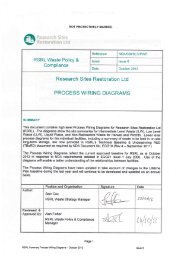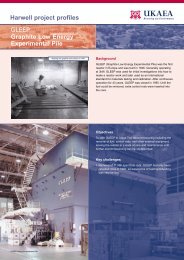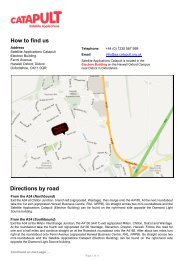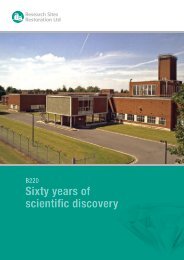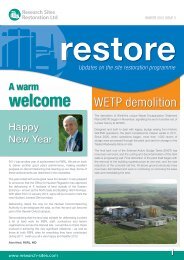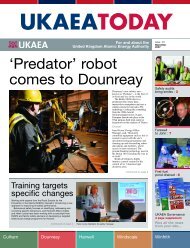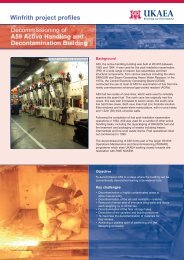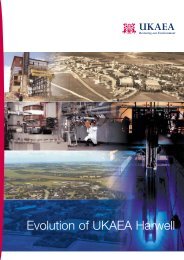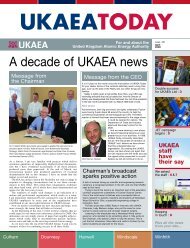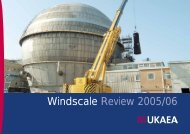RSRL Integrated Waste Strategy - Issue 5- Oct 2012.pdf
RSRL Integrated Waste Strategy - Issue 5- Oct 2012.pdf
RSRL Integrated Waste Strategy - Issue 5- Oct 2012.pdf
You also want an ePaper? Increase the reach of your titles
YUMPU automatically turns print PDFs into web optimized ePapers that Google loves.
NOT PROTECTIVELY MARKEDPassive SafetyONR’s guidance to its inspectors defines passive safety in the following way:"Passive safety…..requires…..radioactive wastes…..to be immobilised in a form that isphysically and chemically stable and stored in a manner which minimises the need forcontrol and safety systems, maintenance, monitoring and human intervention. Thewastes…..should be stored in discrete packages which are resistant to degradation andhazards and which can be inspected and retrieved for final disposal."Proximity PrincipleThe proximity principle requires waste to be disposed of as close to the place of production aspossible. This avoids passing the environmental costs of waste management to communitieswhich are not responsible for its generation, and reduces the environmental costs oftransporting waste. In considering waste management options there should be assessment ofwhere environmental burdens fall in relation to particular sectors of society and recognition ofpotential adverse impacts on health and quality of life, in relation to other potential benefits tothe social and economic needs of the area. The proximity principle has been defined primarilyfor non-radioactive wastes. For radioactive wastes it is a consideration to be taken intoaccount, rather than an absolute principle. Most radioactive wastes that exist or will arise in thefuture will be owned by a small number of mainly public bodies (such as the NDA). For practicalpurposes radioactive waste creation and waste management are as closely linked as possible.Consideration needs to be given to balancing the impacts of waste transport against theconcentration of radioactive wastes to ensure they can be securely and safely managed.Robust Concrete BoxAn IP-2 rated radioactive transport package (previously known as the WAGR box).Secondary <strong>Waste</strong>This is waste produced as a by-product of processing the primary waste stream.Nuclear Material (NM)“Nuclear Material" (NM) is defined by Title I of the Atomic Energy Act of 1954 as plutonium,uranium-233, or uranium enriched in the isotopes uranium-233 or uranium-235. The definitionincludes any other material that the Commission determines to be nuclear material, but doesnot include source material. The IWS will cover NM that is currently identified as a waste orwhere it may be destined for a waste route in the future.Sustainability – Sustainable DevelopmentThis has been widely defined as ‘development which meets the needs of the present withoutcompromising the ability of future generations to meet their own needs. The followingrequirements should be met:• <strong>Waste</strong> management should not impose undue burdens on future generations and theirenvironment such that it compromises their ability to meet their needs.• Even given a legacy of appropriate financial resources, future generations should preferablynot have to divert time and effort to managing wastes generated by present and pastgenerations. They should be free to pursue their own preoccupations.• Decisions should be based on the best possible scientific information and analysis of risks• Where there is uncertainty and potentially serious risk exists, precautionary action may benecessary• Ecological impacts must be considered, particularly where resources are non-renewable oreffects may be irreversible• The underlying principle of “polluter pays” should be recognised in assessing costimplications (the ‘polluter pays’ principle requires producers and owners of wastes to bearthe costs imposed by those wastes, including the costs of regulation and those of relatedresearch undertaken both by themselves and by the regulatory bodies. The evaluation of<strong>RSRL</strong> IWS (<strong>Issue</strong> 5 – <strong>Oct</strong>ober 2012)121




